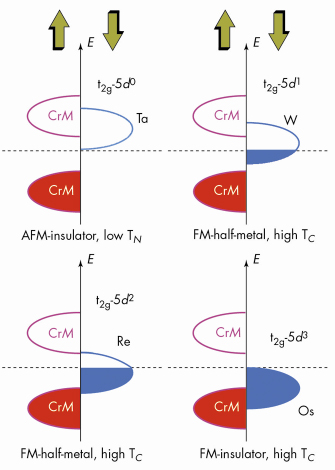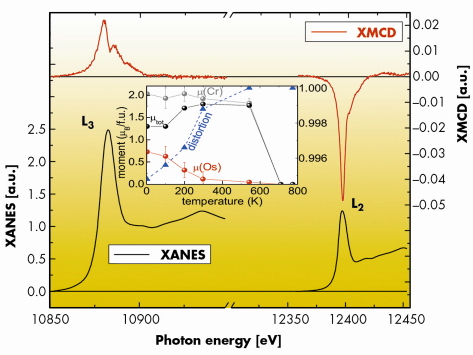- Home
- Users & Science
- Scientific Documentation
- ESRF Highlights
- ESRF Highlights 2007
- X-ray Absorption and Magnetic Scattering
- Novel half-metallic double perovskites for spintronics with tunable conductivity
Novel half-metallic double perovskites for spintronics with tunable conductivity
Materials with a high spin-polarisation of the conducting charge carriers are of great interest for spintronics. In particular, an ideal material with 100% spin-polarisation is called a half-metal. Such materials can be found in several materials classes: In classic oxides such as magnetite or CrO2, in manganites and intermetallic Heusler alloys, but also in the group of double perovskites. Double perovskites are of special interest, since within this group half-metals with above room-temperature transition temperatures are found. At the same time, within the vast perovskite family, heteroepitaxial multilayers of different functional materials such as insulators, magnetic metals, and even superconductors, can be grown for future spintronic devices.
We have rediscovered [1] a double perovskite that has the highest Curie-temperature known so far within this group (725 K or 450°C): Sr2CrOsO6. It was erroneously considered to be non-magnetic at room-temperature. Osmium is certainly an odd element with difficult metallurgy, however, one may remember that filaments in light bulbs are being made from osmium and tungsten. The role of Os in the compound Sr2CrOsO6 is to supply spin-polarised charge carriers. As in the light bulb filament, one can also have tantalum, tungsten, and rhenium at the crystal site of osmium. Since these ions are in the 5+ state, they supply a number of spin-polarised electrons per unit cell, 0, 1, 2 and 3 electrons for Ta, W, Re, and Os, respectively. These spin-polarised electrons are also the glue and origin of ferrimagnetism of these compounds. In the case of Sr2CrTaO6 with no doped electrons, correspondingly, no ferrimagnetism is observed. With increasing number of doped electrons, the Curie-temperature of the compounds also increases: 450 K for Sr2CrWO6, 635 K for Sr2CrReO6, and finally 725 K for Sr2CrReOsO6. With the changing number of electrons, the conductivity also changes. In Sr2CrOsO6 the metallic band (5dt2g) is completely filled. Therefore, Sr2CrOsO6 is an insulator and at the same time it still has the highest Curie-temperature. The band scheme is illustrated in Figure 112 [1]. This result is remarkable because it brings to light the possibility to tune a material in order to obtain fully spin-polarised conductivity in a desired range between a good metal and an insulator. In the future, an elegant way to tune the spin-polarised carrier density in a spintronics device would be to use the field effect.
 |
|
Fig. 112: Simple model of the effect of 5d doping in Sr2CrMO6 with M = Ta, W, Re, and Os. |
In order to elucidate the mechanism of ferrimagnetism in the described double perovskites, it is of utmost importance to measure (separately) the spin and orbital magnetic moments at the Os (or W or Re) site. The magnetic moments of these ions are induced in the specific double perovskite structure from the magnetic Cr3+ ions. Within a model of kinetic energy driven exchange it is expected that the induced spin magnetic moment scales with the Curie-tempereature of the compound [2]. It is the merit of beamline ID12 that such measurements can be made with very high quality. In excellent agreement with neutron scattering experiments, the existence and scaling of the induced magnetic moments has been confirmed unambiguously by X-ray magnetic circular dichroism (XMCD) experiments (Figure 113). At the Os site, a spin-magnetic moment of -0.17 µB/formula unit (the minus sign indicates the anti-parallel orientation with respect to the Cr magnetisation) and an orbital magnetic moment of 0.015 µB/formula unit has been measured. In addition, it could be shown that spin-orbit coupling has to be taken into account due to the heavy ionic mass of Os.
 |
|
Fig. 113: X-ray absorption near-edge structure (XANES, left axis) and XMCD signal (right axis) at the Os L2 and L3 edges in Sr2CrOsO6. The inset shows the element-resolved magnetic moments of Cr (µCr) and Os (µOs), the total magnetic moment (µtot), and the lattice distortion as determined from neutron scattering. |
In conclusion, we have shown that the mechanism of magnetic coupling in the ferrimagnetic double perovskites also applies to insulating compounds with filled bands, where even the highest Curie-temperature is observed for this class of materials. This finding may contribute to the development of thin-film based field-effect transistors with the ability of switching between high and low conductivity that is in both cases fully spin-polarised and therefore desirable for spintronics.
References
[1] L. Alff, in Electron Correlation in New Materials and Nanosystems, K. Scharnberg, S. Kruchinin (Eds.), NATO Science Series II 241, 393-400 (2007).
[2] P. Majewski, S. Geprägs, O. Sanganas, M. Opel, R. Gross, F. Wilhelm, A. Rogalev, L. Alff, Appl. Phys. Lett. 87, 202503 (2005).
Principal publication and authors
Y. Krockenberger (a,b), K. Mogare (b), M. Reehuis (b,c), M. Tovar (c), M. Jansen (b), G. Vaitheeswaran (b,d), V. Kanchana (b,d), F. Bultmark (e), A. Delin (d), F. Wilhelm (f), A. Rogalev (f), A. Winkler (a), L. Alff (a), Phys. Rev. B 75, 020404(R) (2007).
(a) Institut für Materialwissenschaft, TU Darmstadt (Germany)
(b) Max-Planck-Institut für Festkörperforschung, Stuttgart (Germany)
(c) HMI, Berlin (Germany)
(d) Department of Materials Science and Engineering, KTH Stockholm (Sweden)
(e) Department of Physics, University of Uppsala (Sweden)
(f) ESRF



